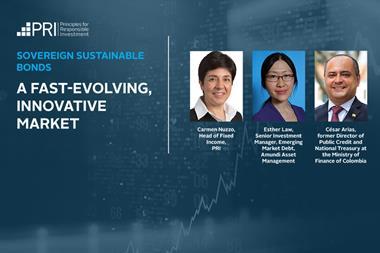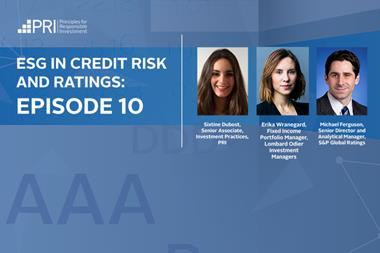Indices help shape investment decisions, whether investors track them passively or use them as a benchmark for performance. Therefore, the index providers incorporating environmental, social and governance (ESG) factors into a growing number of their products are key actors in the responsible investment ecosystem.
When designing ESG indices for government bonds, there are certain differences compared with corporate indices. This podcast explores these distinctions, as well as the purpose of ESG sovereign debt indices and potential areas for future development.
Find the podcast transcript here
Bringing ESG factors into sovereign debt indices
With Jasper Cox, Investment Practices Analyst, Fixed Income, PRI, Lupin Rahman, Head of Emerging Markets Sovereign Credit, Pimco and Jarrad Linzie, Global Head of Fixed Income index research, MSCI
Note: The Principles for Responsible Investment podcast is designed to be heard. If you are unable to do this, this transcript offers an insight into the episode.
Transcripts are generated using a combination of speech recognition software and human transcribers, and may contain the occasional error. Please check the corresponding audio before quoting in print.
Subscribe to the channel via Apple podcasts, Spotify, or wherever you listen to your podcasts.
Jasper Cox
Hello, and welcome to the PRI podcast. I’m Jasper Cox, a fixed income analyst in the investment practices team at the PRI. Indices play a crucial role in shaping investment decisions and capital flows because many investors either track them passively or use them as a benchmark to measure relative performance. Given that investors are thinking more and more about incorporating environmental, social and governance factors. It’s not surprising that a growing number of ESG indices have been developed. A lot goes into designing these indices and creating the rules that govern them, meaning index providers are key players in sustainable finance. Today, we’re going to discuss ESG indices in the sovereign debt markets, specifically the market where governments fund themselves through issuing bonds. We’re going to cover the purpose of these indices, some of the nuances compared with corporate ESG indices and potential future areas for index development.
I’m very pleased to be joined by Lupin Rahman, who is head of emerging markets, sovereign credit at PIMCO. And so brings the perspective of the investor, she is also a member of the PRI’s sovereign debt advisory committee. Also joining me is Jarrad Lindsay, global head of fixed income index research, MSCI, giving the point of view of the index provider. I’m going to turn first of all, to Lupin as the investor in the room to kick us off. Why do sovereign bond holders use ESG industries?
Lupin Rahman
Well, clients use benchmarks for several reasons, but primarily to assess the performance of the active manager. And so when an asset owner or a consultant is looking for an ESG oriented solution, it is a natural extension of that ethos of using some form of benchmark to use as an indicator of a performance criteria for managers. I think that what is different about ESG indices is that, ESG means different things to different asset owners and to different investors. I would say that almost the majority of our clients have tailored benchmarks when it comes to ESG mandates, but there is growing recognition that some of the index providers that are out there are also reorienting their products for what the majority of clients are looking for. For investors, ESG indices are useful. It helps to have a focus on a certain subgroup of countries which are viewed as acceptable or eligible for index inclusion that offers a very useful checklist for asset owners and investors to re-assess some of their priors. If they’re investing in countries that aren’t part of a benchmark, for example.
Jasper Cox
Key point there that ESG means different things to different investors turning to you. Now, Jarrad is the index provider representative. How do you go about forming an ESG index from an existing bond index?
Jarrad Linzie
I’ve built indices for the last 20 years? I think first and foremost, it’s always important to engage with the end user, whether that’s an asset manager, asset owner, or consultant. I think it’s critical when we think about any benchmark or an index construction for the investment community. Now beyond that, there’s a few critical points that I think we need to adhere to as index providers. You know, when thinking about integrating ESG, I want to start with what are the ESG strategies that actually exist today. And it’s really only three, one would be exclusionary. The second would be integration slash tilting. And the last would just be a combination of the two, exclusionary plus integration slash tilting. My preference would always be having some integration and also having some exclusion, right? So what you want to do is make sure that you tilt the issuers that are in a better standing from an ESG characteristics perspective.
And then maybe you have some exclusions of issuers that are not really adhering or trying to better themselves from an ESG classification. Once you get that in place and you figure out the strategy, then you start to look at the overall index itself and say, there’s a parent index that everyone is accustomed to where there’s potentially hundreds of billions of dollars dedicated to that strategy. So, you want that strategy or your ESG strategy to mimic or resemble the parent index itself. And what that is. As an example, you want your ESG index to maybe mimic or resemble the yield spreads, durations the average rating of the parent. And again, I just want to emphasise resemble. It’s never going to be exactly the same, but it needs to have the look and feel of that index for managers to kind of really utilise it. One thing that we want to hone in on, and it’s really important is avoiding concentration risks due to the ESG data itself. Now, you know, concentration risks can be very problematic because it does naturally impact diversification. It impacts liquidity. It could also impact the overall risk limits of managers themselves, where they may not be able to own X, Y, Z, or X amount of a bond because it breaches their own respective risk limits. So concentration risk is actually very, very problematic. And that’s something that we really want to avoid more than anything.
Jasper Cox
You talked about the problem of concentration risk. If you exclude too many issuers, would that make concentration risk more of a problem?
Jarrad Linzie
1000%, right? So that, that’s why you don’t want to have just, you know, an exclusionary issue, right? Because then you can create that amount of concentration and there needs to be a balance, right? You know, what, what is that balance? It depends on how diversified the index is, where you can construct certain rules and criteria, but you don’t want to have a huge amount of concentration risk or a huge amount of exclusions, where then you say I started with a thousand issuers and due to the exclusions. Now I’m only left with 200 issuers. You know, I think that’s going to create a huge amount of issues when we thinking about replication and, and just the tradeability of the end product itself. Yeah. You want to have that right balance between exclusions and tilting.
Jasper Cox
I’ve got a question for both of you now, what’s different about sovereign debt compared with corporate securities when it comes to designing an ESG index, looping, do you want to start?
Lupin Rahman
Sure. I think one of the biggest challenges is something that Jarrad touched on before. And that is just the, the size on the universe of sovereigns compared to corporates. The fact that you have a much smaller size of investible sovereigns means that this issue of concentration risk becomes really important. And it also means that if you do have a number of sovereigns, which are excluded, you could end up having biases within the index, which are really quite perverse. So for example, you may end up with sovereigns that are excluded based on governance issues, but that may result in say an index with much higher fossil fuel intensity, just as an example. The other thing that makes sovereign indices just slightly different from when we consider ESG in, corporates, is that there is this element of wanting to have impact and engage with the issuer and move them along better ESG practices, which is inherently more complicated when you are looking to interact and influence and engage with sovereign versus corporates.
Jarrad Linzie
Yeah. I mean, I totally agree with that Lupin wholeheartedly. And I think one of the bigger issues as well is just the access of data corporates have been around for a fair amount and a lot of the ESG data and the framework itself is using what’s there, or the framework there for equity. So it’s easily to translate into corporate issuers. And depending on the asset classes, there’s a lot of data that’s being covered. So, if you’re looking at us investment grade where let’s call it, 90% of the universe is listed, you have a fair amount of data to actually use. When it comes to sovereigns, the framework becomes very, very different because you don’t have as much forward looking. You don’t have as much transparent data when assessing sovereigns. Hence why, you know, I, I don’t believe in too much of exclusions. You need to have exclusions to have the right amount of impact and balance, but I almost feel that instead of E meaning environmental, it should also mean engagement. And Lupin mentioned the word engagement. We need to be sure that these index products provide a level of engagement in itself. I would say that sovereigns is much more difficult just because we don’t have the same level of data access. And then we start to even think about the strategies in itself. Should we start to incorporate trajectory as a component of index construction?
Jasper Cox
And that question about trajectory is something that comes up all the time. When we talk about ESG and sovereign debt. Both PIMCO and MSCI took part in a recent workshop that the PRI held with sovereign debt investors and index providers to discuss ESG sovereign debt indices. You can find a link to the article on that workshop. In the episode description, in that workshop, we discuss data challenges in creating a methodology, Jarrad, what are some of the challenges and how can providers get around them?
Jarrad Linzie
So there’s no really getting around the data challenges. It’s really trying to figure out how do you integrate those challenges within a methodology in its own. As an example, one would say there’s a slew of debut issuers every single year, but we know from an ESG data perspective, you may not get data for those debut issuers from the onset. So, what do you do? Maybe you provide a sector regional average or a regional average so that you can include that issuer. It’s different for sovereigns and corporates because sovereigns don’t really have any business screens, but whenever you start to think about corporates, you want to make sure that you adhere to the respective business screens and not include things that are like firearms and thermal, coal and tobacco and things of that nature. The index should have some foresight and understand how the market evolves, but there’s no crystal ball to kind of tell you, we need to do exactly this. I think what we need to do is make sure that the index is nimble enough that there’s enough outreach. There’s a lot of QC on the data itself, because what happens is that the data sometimes, you know, becomes a bit erroneous or there might be not enough checks and balances from the ESG provider. So it’s really important that the index takes that all into account. It’s about making sure that the index is truly representative of the respective strategy, but then is really evolving as the data itself gets better.
Lupin Rahman
Just to add to that. I think, you know, one of the unique features of sovereigns is that there is an electoral cycle. That means that sovereigns policies, particularly on ESG elements can change very, very quickly. And you can have very binary shifts in terms of what asset owners would want to have in the ESG index. I think the reason why I mentioned this is because the reputational risk for ESG investors to own certain credits where there have been very large announced, very important announcements based on ESG. Say for example, climate, when a new president comes in is really, really high. And so incorporating those factors into the methodology can actually be a challenge, which seems to be much more an issue for sovereigns rather than in the corporate sphere.
Jasper Cox
And what types of ESG sovereign debt industries do you think we could see emerge in the coming years?
Lupin Rahman
Well, I think that as this asset class evolves, we are likely to see the types of indices, which are required both by regulators, as well as asset owners also evolve. I think in the very near term, we’ll probably see more inclusion of ESG labelled issuances, like green bonds, social bonds, SLB, and perhaps a greater focus on the types of issuers that have made targets and mandates that are really aligned to ESG practices. But beyond that, we are seeing greater demand for net zero benchmarks. And thinking about how Sovereign’s pathways towards achieving Paris alignment are evolving. So I would expect the ESG sovereign debt indices to move along a similar path in terms of trying to fulfil that demand.
Jarrad Linzie
Yeah, I agree with all those things, the sustainable bond universe is growing rapidly and there’s increased demand, you know, for those type of securities. And I would also agree with Paris aligned benchmarks and you can also add climate transition benchmarks. So I do think that there is going to be more adherence to think about net zero, look out for let’s call it climate change or climate transition type benchmarks that we’re really focus on the E. We need to have more choices when we think about new benchmarks in itself. So there’s gonna be a lot of options, but it all depends on everyone’s trajectory and where they currently stand, which is why we’re gonna need more customized solutions.
Jasper Cox
When it comes to label bonds. Do you think indices might have a greater role to play there? For example, Chili’s issued green bonds, social bonds, sustainable bonds, and sustainability linked bonds.
Could an index take greater account of the type of label that an issuer issues with?
Lupin Rahman
Absolutely. And I think here index providers have a really important role to play, not only in terms of including ESG labelled bonds indices, but also perhaps helping investors monitor factors such as reporting, requirements or triggers for certain parts or certain components of the, the bond structure. And I think that right now, there is quite a large gap in the market in terms of really monitoring these reporting requirements. And so, a natural fit would be for benchmark index providers to fill that gap.
Jarrad Linzie
I would say it’s not an easy gap to fill, but I 100% agree with you. I mean, the, the reality is there there’s a rise in index labelled funds. There’s a rise of the retail investor and just being able to provide the end user, the asset manager, asset owner, just a detailed attribution of what’s labelled. What’s not. And then I guess, you know, moving forward when we start to even think about impact benchmarks in itself, I think that there is going to be a huge opportunity for index providers to provide a bit more insight.
Jasper Cox
Well, lots of room for further growth then. Thank you for your time today, Lupin and Jarrad, you can find more of our resources on sovereign debt at unpri.org/sovereign-debt. Please also take a look at unpri.org/fi for other resources related to fixed income more broadly. Thanks for listening and tune in next time for our episode on Carbon pricing with Ed Baker.
Interested in the resources discussed in this episode?
Bringing together sovereign debt investors and index providers
Downloads
Transcript
PDF, Size 0.2 mb



















